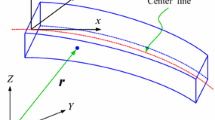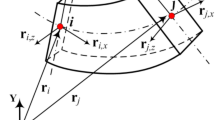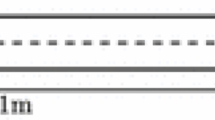Abstract
The present paper mainly concentrates on dynamic modeling and analysis of the isotropic, hyperelastic and nonlinear nearly incompressible silicone beams adopting higher-order beam elements based on absolute nodal coordinate formulation (ANCF), and the combined use of higher-order beam elements with nonlinear incompressible material model is developed. Different from the previously proposed conventional lower-order fully parameterized ANCF beam element for modeling of rubber-like beams, in which linear interpolation in the transverse directions is used, the higher-order beam element which covers quadratic interpolation in the transverse directions is employed to investigate dynamic behaviors of silicone beams within the ANCF framework. The utilization of the higher-order beam element cannot only avoid the stiffening problem caused by volumetric locking, but also improve precision in simulating large bending deformation compared with the modified lower-order beam element based on selective reduced integration method for the particular silicone beams considering damping. By introducing the volumetric energy penalty function, the nonlinear elastic force and its derivative formulations of the Arruda–Boyce model are deduced. The availability and accuracy of the higher-order beam element are verified and compared firstly through static equilibrium experiment and ANSYS simulation. Subsequently, the dynamic experimental investigation that captures free-falling motion of the silicone cantilever beam under the action of gravitational force is executed, then corresponding dynamic simulations are implemented employing three types of different beam elements in consideration of damping effect, and the simulation results are compared with experimental data. The validity, simulation accuracy of different beam elements and diverse nonlinear constitutive models in the dynamic analysis are discussed. In addition, the superiority of the higher-order beam element relative to two other types of lower-order beam elements can be further examined through physical experiment.












Similar content being viewed by others
References
Shabana, A.A.: An absolute nodal coordinate formulation for the large rotation and deformation analysis of flexible bodies. Technical Report MBS96-1-UIC, University of Illinois at Chicago, Chicago (1996)
Shabana, A.A.: Definition of the slopes and the finite element absolute nodal coordinate formulation. Multibody Syst. Dyn. 1(3), 339–348 (1997)
Yakoub, R.Y., Shabana, A.A.: Three-dimensional absolute nodal coordinate formulation for beam elements: implementation and applications. J. Mech. Des. 123, 614–621 (2001)
Shabana, A.A., Yakoub, R.Y.: Three-dimensional absolute nodal coordinate formulation for beam elements: theory. J. Mech. Des. 123, 606–613 (2001)
Shabana, A.A., Schwertassek, R.: Equivalence of the floating frame of reference approach and finite element formulations. Int. J. Non-Linear Mech. 33(3), 417–432 (1998)
Shabana, A.A.: Computational Continuum Mechanics. Cambridge University Press, Cambridge (2008)
Berzeri, M., Shabana, A.A.: Development of simple models for the elastic forces in the absolute nodal coordinate formulation. J. Sound Vib. 235(4), 539–565 (2000)
Omar, M.A., Shabana, A.A.: A two-dimensional shear deformable beam for large rotation and deformation problems. J. Sound Vib. 243, 565–576 (2001)
Sopanen, J.T., Mikkola, A.K.: Description of elastic forces in absolute nodal coordinate formulation. Nonlinear Dyn. 34, 53–74 (2003)
Yoo, W., Lee, J., Park, S., Shon, J., Dmitrochenko, O., Pogorelov, D.: Large oscillations of a thin cantilever beam: physical experiments and simulation using the absolute nodal coordinate formulation. Nonlinear Dyn. 34, 3–29 (2003)
Yoo, W., Lee, J., Park, S., Shon, J., Dmitrochenko, O., Pogorelov, D.: Large deflection analysis of a thin plate: computer simulations and experiments. Multibody Syst. Dyn. 11(2), 185–208 (2004)
Shabana, A.A.: Computer implementation of the absolute nodal coordinate formulation for flexible multibody dynamics. Nonlinear Dyn. 16, 293–306 (1998)
Gerstmayr, J., Shabana, A.A.: Efficient integration of the elastic forces and thin three-dimensional beam elements in the absolute nodal coordinate formulation. In: ECCOMAS Thematic Conference, Madrid, pp. 21–24 (2005)
Matikainen, M.K., Dmitrochenko, O.: A study of three-node higher-order gradient beam elements based on the absolute nodal coordinate formulation. In: The 3rd Joint International Conference on Multibody System Dynamics, Busan, Korea (2014)
Orzechowski, G., Shabana, A.A.: Analysis of warping deformation modes using higher order ANCF beam element. J. Sound Vib. 363, 428–445 (2016)
Patel, M., Orzechowski, G., Tian, Q., Shabana, A.A.: A new multibody system approach for tire modeling using ANCF finite elements. Proc. Inst. Mech. Eng., Proc. Part K, J. Multi-Body Dyn. 230(1), 69–84 (2016)
Ebel, H., Matikainen, M.K., Hurskainen, V.V., Mikkola, A.M.: Higher-order beam elements based on the absolute nodal coordinate formulation for three-dimensional elasticity. Nonlinear Dyn. 88(1), 1075–1091 (2017)
Matikainen, M.K., Dmitrochenko, O., Mikkola, A.M.: Beam elements with trapezoidal cross section deformation modes based on the absolute nodal coordinate formulation. In: International Conference of Numerical Analysis and Applied Mathematics, Rhodes, Greece, pp. 19–25 (2010)
Matikainen, M.K., Dmitrochenko, O., Mikkola, A.M.: Higher order beam elements based on the absolute nodal coordinate formulation. In: Multibody Dynamics 2011, ECCOMAS Thematic Conference, Brussels, Belgium, pp. 4–7 (2011)
Shen, Z., Li, P., Liu, C., Hu, G.: A finite element beam model including cross-section distortion in the absolute nodal coordinate formulation. Nonlinear Dyn. 77(3), 1019–1033 (2014)
Maqueda, L.G., Shabana, A.A.: Poisson modes and general nonlinear constitutive models in the large displacement analysis of beam. Multibody Syst. Dyn. 18, 375–396 (2007)
Maqueda, L.G., Mohamed, N.A., Shabana, A.A.: Use of general nonlinear material models in beam problems: application to belts and rubber chains. J. Comput. Nonlinear Dyn. 5(2), 021003 (2010)
Arruda, E.M., Boyce, M.C.: A three-dimensional constitutive model for the large stretch behavior of rubber elastic materials. J. Mech. Phys. Solids 41, 389–412 (1993)
Luo, K., Liu, C., Tian, Q., Hu, H.Y.: Nonlinear static and dynamic analysis of hyper-elastic thin shells via the absolute nodal coordinate formulation. Nonlinear Dyn. 85(1), 949–971 (2016)
Jung, S., Park, T., Chung, W.: Dynamic analysis of rubber-like material using absolute nodal coordinate formulation based on the nonlinear constitutive law. Nonlinear Dyn. 63(1), 149–157 (2011)
Gerstmayr, J., Sugiyama, H., Mikkola, A.: Review on the absolute nodal coordinate formulation for large deformation analysis of multibody systems. J. Comput. Nonlinear Dyn. 8, 031016 (2013)
Nachbagauer, K.: State of the art of ANCF elements regarding geometric description, interpolation strategies, definition of elastic forces, validation and the locking phenomenon in comparison with proposed beam finite elements. Arch. Comput. Methods Eng. 21(3), 293–319 (2014)
Kuhl, D., Ramm, E.: Time integration in the context of energy control and locking free finite elements. Arch. Comput. Methods Eng. 7, 299–332 (2000)
Orzechowski, G., Fraczek, J.: Nearly incompressible nonlinear material models in the large deformation analysis of beams using ANCF. Nonlinear Dyn. 82(1), 451–464 (2015)
Gerstmayr, J., Matikainen, M.K., Mikkola, A.M.: A geometrically exact beam element based on the absolute nodal coordinate formulation. Multibody Syst. Dyn. 20(4), 359–384 (2008)
Elguedj, T., Bazilevs, Y., Calo, V.M., Hughes, T.J.: B-bar and \(F\)-bar projection methods for nearly incompressible linear and non-linear elasticity and plasticity using higher-order NURBS elements. Comput. Methods Appl. Mech. Eng. 197(33–40), 2732–2762 (2008)
Bechir, H., Chevalier, L., Chauche, M., Boufala, K.: Hyperelastic constitutive model for rubber-like materials based on the first Seth strain measures invariant. Eur. J. Mech. A, Solids 25, 110–124 (2006)
Hussein, B.A., Weed, D., Shabana, A.A.: Clamped end conditions and cross section deformation in the finite element absolute nodal coordinate formulation. Multibody Syst. Dyn. 21(4), 375–393 (2009)
Bonet, J., Wood, R.D.: Nonlinear Continuum Mechanics for Finite Element Analysis. Cambridge University Press, Cambridge (1997)
Rivlin, R.S., Saunders, D.W.: Large elastic deformations of isotropic materials VII. Experiments on the deformation of rubber. Philos. Trans. R. Soc. Lond. Ser. A 243(865), 251–288 (1951)
Ogden, R.W.: Large deformation isotropic elasticity: on the correlation of theory and experiment for compressible rubber-like solids. Proc. R. Soc. Lond. Ser. A, Math. Phys. Sci. 328, 567–583 (1972)
Simo, J.C., Taylor, R.L.: Penalty function formulations for incompressible nonlinear elastostatic. Comput. Methods Appl. Mech. Eng. 35, 107–118 (1982)
Bergstrom, J.S., Boyce, M.C.: Deformation of elastomeric networks: relation between molecular level deformation and classical statistical mechanics models of rubber elasticity. Macromolecules 34(3), 614–626 (2001)
Hiermaier, S.J.: Structures Under Crash and Impact: Continuum Mechanics, Discretization and Experimental Characterization. Springer, Berlin (2008)
Gent, A.N.: A new constitutive relation for rubber. Rubber Chem. Technol. 69(1), 59–61 (1996)
Lee, J.W., Kim, H.W., Ku, H.C., Yoo, W.S.: Comparison of external damping models in a large deformation problem. J. Sound Vib. 325(4–5), 722–741 (2009)
Rao, S.S.: Mechanical Vibrations, 5th edn. Prentice Hall, New Jersey (2010)
Breslavsky, I.D., Amabili, M., Legrand, M.: Nonlinear vibrations of thin hyperelastic plates. J. Sound Vib. 333(19), 4668–4681 (2014)
Acknowledgements
This research was supported by General Program (No. 11772186, No. 11272203) of the National Natural Science Foundation of China for which all authors are grateful.
Author information
Authors and Affiliations
Corresponding author
Additional information
Publisher’s Note
Springer Nature remains neutral with regard to jurisdictional claims in published maps and institutional affiliations.
Appendix
Appendix
In this appendix, the derivations of some identities used in this present investigation to obtain the elastic forces associated with the nonlinear elastic constitutive models in the absolute nodal coordinate formulation are presented. Recall that the deformation gradient tensor \(\mathbf{J}\) is given by
Defining
The right Cauchy–Green deformation tensor is
The first strain invariants of the tensor can be written as
The derivative of \(I_{1}\) with respect to the element absolute nodal coordinate \(\mathbf{q}_{e}\) is deduced as
Recall that the determinant of the deformation gradient tensor takes the form
where
The derivative of the determinant of the deformation gradient tensor with respect to the element absolute nodal coordinate \(\mathbf{q} _{e}\) is expressed as
Rights and permissions
About this article
Cite this article
Xu, Q., Liu, J. & Qu, L. Dynamic modeling for silicone beams using higher-order ANCF beam elements and experiment investigation. Multibody Syst Dyn 46, 307–328 (2019). https://doi.org/10.1007/s11044-019-09668-2
Received:
Accepted:
Published:
Issue Date:
DOI: https://doi.org/10.1007/s11044-019-09668-2




